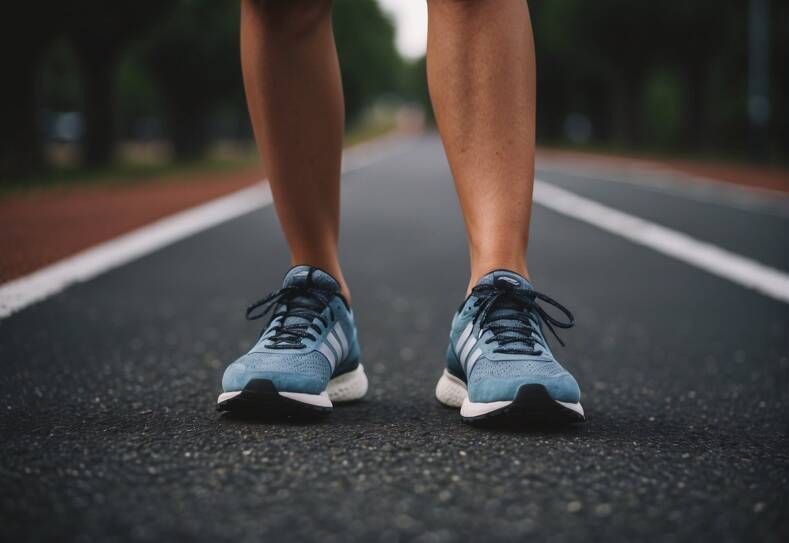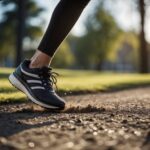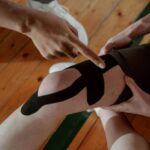Running form is a critical aspect of efficient and safe running. Heel striking is a common habit where a runner’s heel is the first part of the foot to make contact with the ground. While prevalent among distance runners, whether heel striking is conducive to optimal running performance is debated. To correct heel strike running, understanding the biomechanics of proper running form becomes essential. The dynamics of human movement during running involve a complex interaction between the foot, ankle, knee, and hip, which collectively work to absorb the shock from ground contact.
When addressing heel strike running, the goal is to transition toward a foot strike that reduces unnecessary impact forces and improves overall running efficiency. This involves a combination of adjustments to a runner’s posture, foot strike position, and cadence. A forefoot or midfoot strike, where the ball of the foot or the whole foot contacts the ground, is commonly encouraged. These alternative foot strikes can potentially reduce braking forces and improve the body’s natural shock absorption.
Transitioning away from heel striking requires practice and a gradual approach. Runners may need to engage in exercises that increase foot and ankle strength, adjust running cadence, and focus on body awareness to create long-term changes in their running pattern. The aim is to foster a running stride that allows for a lighter, more responsive footfall and a stable, balanced body position throughout the gait cycle, ultimately leading to a more efficient and potentially injury-free running experience.
Understanding Running Mechanics
When one examines running mechanics, it’s imperative to consider the gait cycle and foot strike patterns. These elements are critical to running efficiency and can influence the overall kinetic chain, which comprises interlinked segments of the body.
Running Gait Fundamentals
Running gait refers to the sequence of movements that occur during running. This cycle consists of two main phases: the stance phase and the swing phase. During the stance phase, the foot makes contact with the ground and supports the body’s weight. The stance phase is followed by the swing phase, where the foot lifts off and moves forward to begin the next step.
The gait cycle plays a significant role in the biomechanics of running, directly affecting the running economy. A runner’s ability to efficiently convert kinetic energy into forward motion is a cornerstone of an effective running gait.
The Role of Foot Strike
The point of initial contact between the foot and ground during running is known as foot strike. The three primary foot strike patterns are:
- Heel strike: where the heel touches down first before the rest of the foot rolls forward.
- Midfoot strike: characterized by the foot landing flat, distributing impact more evenly.
- Forefoot strike: involves landing on the ball of the foot, often seen in sprinters or when runners accelerate.
Each foot strike pattern affects the biomechanical load on the kinetic chain differently. A heel strike, for example, may lead to increased impact forces traveling up the leg, which some believe could lead to a higher risk of injury. Conversely, a forefoot strike might improve running economy by leveraging the natural elasticity of the calf muscles and Achilles tendon. However, a one-size-fits-all approach does not exist; the ideal foot strike varies by individual and can depend on anatomical factors, running experience, speed, and surface.
Analyzing Heel Striking
When runners analyze their heel striking, they often discover a connection between their gait and potential for injuries. The manner in which the foot makes contact with the ground can have significant implications for the runner’s overall biomechanics.
Common Issues with Heel Striking
Overstriding is frequently observed in heel strikers, characterized by the leg extending too far ahead of the body and the heel striking the ground first – this is known as a rearfoot strike. This gait can lead to increased impact forces traveling up the leg, which have been associated with a higher risk of running injuries. Runners might also experience inefficient propulsion since the foot strikes the ground with excessive braking force.
- Potential Running Injuries:
- Stress fractures
- Shin splints
- Plantar fasciitis
Comparing Heel Strike to Midfoot and Forefoot Striking
Heel striking differs markedly from other forms of foot strike, namely midfoot and forefoot striking. While heel striking involves the rearfoot contacting the ground first, midfoot striking sees runners landing flat-footed, and forefoot strikers land on the balls of their feet.
- Differences in Impact:
- Heel Striking: Higher initial impact forces, potential for inefficiency.
- Midfoot Striking: Reduced impact, a balance between cushioning and propulsion.
- Forefoot Striking: Lower initial impact, but requires strong calf muscles and can strain the Achilles tendon.
Compared to heel striking, midfoot and forefoot strikes typically involve a shorter gait and quicker cadence, which may reduce overstriding and thus decrease the risk of impact-related injuries.
Improving Running Technique
Optimizing running technique not only increases efficiency but also reduces the risk of injury. This section focuses on transitioning away from heel striking to a more favorable form and implementing drills that solidify proper running mechanics.
Transitioning from Heel Strike
The goal is to shift from a heel strike to a midfoot or forefoot strike to lessen impact forces and enhance propulsion. They are steps to consider when transitioning:
- Closely Monitor Overstriding: Overstriding occurs when the foot lands too far in front of the body’s center of gravity, often resulting in a heel strike. By taking shorter, quicker strides, one can avoid overstriding and enhance their running cadence.
- Adjust Forward Lean: A slight forward lean from the ankles, not the waist, can encourage a midfoot strike. This lean should be subtle and help to naturally position the feet beneath the body.
- Mind Arm Swing: Arm movement synchronizes with leg motion. Keeping arm swings compact and controlled can indirectly aid in maintaining a proper stride and avoiding overstriding.
Drills for Better Form
To reinforce efficient running form, there are specific drills athletes can practice regularly:
- Cadence Drills: Using a metronome or a running watch, one can set their desired cadence and match their step rate to this rhythm. Aim for a cadence of around 170-190 steps per minute.
- Barefoot Drills: Performing short runs or drills on a soft surface without shoes allows runners to naturally adopt a midfoot strike due to the increased sensory feedback from their feet.
| Drill Type | Description | Frequency |
|---|---|---|
| Cadence | Step rate timing | Daily |
| Barefoot | Sensory feedback | 1-2x week |
By gradually incorporating these adjustments and drills, runners can develop a more effective and efficient running technique.
Injury Risk and Prevention
When runners employ a heel strike pattern, they may expose different areas of their lower body to injury. Understanding common injuries and adopting prevention strategies can safeguard one’s joints and enhance mobility.
Common Injuries Associated with Heel Striking
Runners who predominantly land on their heels are at increased risk of knee and hip-related injuries. Research suggests that heel striking can lead to conditions such as:
- Patellofemoral pain syndrome: Often felt around the knee cap.
- Iliotibial band syndrome (ITBS): Causes lateral knee pain and is related to the hip.
The action of heel striking can cause excessive stress on the Achilles tendon and the calf muscles, potentially resulting in overuse injuries like Achilles tendinitis.
Strategies for Injury Prevention
To prevent these injuries, runners may want to consider the following:
- Improve ankle mobility: Flexible ankles allow for a smoother transition from heel to toe.
- Enhance hip mobility: This can reduce the stress on the knee by promoting a more neutral foot strike.
- Strengthening exercises: Focusing on the lower body improves joint stability.
Incorporating uphill running and running form drills can help shift the foot strike pattern from heel to midfoot or forefoot, thus aligning the body’s natural mechanics and reducing injury risk.
Strength and Flexibility Training
Strength and flexibility are crucial for correcting heel strike during running. Focused exercises can build lower body strength while improving ankle and hip mobility, both of which are essential for runners who aim to transition to a more efficient foot strike.
Exercises for Lower Body Strength
Strong calf muscles and achilles tendons are fundamental for runners. They transition force and stabilize the legs upon foot strike, whether heel, midfoot, or forefoot.
Calf Raises
- Stand on the edge of a step.
- Rise onto the balls of the feet.
- Lower down below the level of the step.
- Perform 3 sets of 10-15 repetitions.
Squats
- Stand with feet shoulder-width apart.
- Bend knees to lower body as if sitting back into a chair.
- Keep the chest up and back straight.
- Rise back up to standing.
- Complete 3 sets of 8-12 repetitions.
Improving Ankle and Hip Mobility
Ankle dorsiflexion and hip flexibility allow for a smoother gait cycle and proper alignment, reducing strain on lower body joints during running.
Ankle Circles
- Sit down with legs extended.
- Rotate the ankle clockwise for 10-15 rotations.
- Switch and rotate counterclockwise for 10-15 rotations.
- Repeat on the other ankle.
Hip Flexor Stretch
- Kneel on one knee, the other foot in front.
- Lean into the front leg, pushing hips forward.
- Hold for 20-30 seconds.
- Switch legs and repeat.
For both strength and flexibility training, maintaining a regular routine will yield the best results. Runners should incorporate these exercises into their training regimen several times a week to support a gradual transition to a more efficient running form.
Selecting the Right Footwear
When selecting running shoes, it’s crucial to consider shoe features that are suited to an individual’s running style and how they can influence running form, particularly for heel strikers.
Shoe Features for Different Running Styles
- Distance Runners: They should look for shoes with ample cushioning to absorb impact and a moderate heel-to-toe drop that promotes a smooth transition from heel strike to toe-off.
- New Balance 880 or Brooks Adrenaline GTS are examples that offer the necessary support and cushioning.
- Cushioning: Essential for reducing impact stress on joints.
- Heel-to-toe drop: A drop of about 8-12 mm is beneficial for heel strikers.
- Stability: Key for runners who experience excessive foot rotation during their stride.
- Sprinters: The focus on speed demands a different set of features in running shoes.
- Flexibility: Allows for swift foot movement.
- Lightweight: Improved speed due to less weight.
- Minimalist Running: It’s a style that mimics barefoot running and aims to encourage a midfoot or forefoot strike.
- Minimal Cushioning: To assist in the transition away from heel striking.
- Low Drop: Generally between 0-4 mm to promote a natural foot strike.
The Impact of Shoes on Running Form
- Heel Strikers: They generally benefit from shoes with features that reduce impact and encourage a gradual transition to a more neutral running form.
- Stability Features: Such as dual-density foams and structured heel counters.
- Cushioning: Specifically in the heel area to provide shock absorption.
- Running Form Adjustments:
- Transitioning Footwear: Gradually moving to shoes with less heel cushioning can help heel strikers adjust their form.
- Consistency: Regular running in the appropriate shoes can lead to form improvements over time.
Each runner’s needs are unique, and they should select shoes based on their specific requirements and running goals. Proper shoe selection can aid in reducing injury risk and improving overall performance.
Running Environment and Surfaces
The surfaces on which an individual runs significantly affect their running form and foot strike. Adjusting to different terrains can lead to improvements in balance and alignment during running.
Effect of Terrain on Running Form
Different terrains impact the running foot strike and overall form. For example:
- Soft Surfaces: Running on a soft surface, such as a trail or grass, can encourage a mid-foot strike as it requires more balance and can decrease the inclination angle of the foot upon impact, promoting better alignment.
- Hard Surfaces: Conversely, road running often results in a heel strike pattern due to the predictable, flat terrain, allowing for consistent contact with the ground.
Running on varied terrain forces the body to adapt its foot strike to maintain stability and efficiency, potentially leading to a more optimized running form.
Training on Varied Surfaces
Incorporating different surfaces into training routines is widely recommended within the running community for the following reasons:
- Develops Muscle Strength: Transitioning between soft and hard surfaces can help runners develop a more resilient musculoskeletal system, as different muscles are engaged to adapt to the changing impact forces.
- Improves Running Technique: By training on varied surfaces, runners may naturally adjust their foot strike to be more conducive to energy efficiency and reduced injury risk.
It is essential for runners to be mindful of the terrain they are training on and to intentionally incorporate variety to challenge their biomechanics and promote improvements in their running form.
Consulting with Professionals
When aiming to correct heel strike running, individuals may significantly benefit from the guidance of knowledgeable professionals. These experts can provide personalized advice and strategies tailored to the runner’s unique biomechanical patterns.
Working with a Running Coach
A running coach specializes in analyzing and enhancing a runner’s technique. They often employ gait analysis, a method that examines an individual’s running form to pinpoint inefficiencies and areas for improvement. Coaches can then work on gait retraining, a structured approach to adjusting the mechanics of running. Runners can expect a hands-on experience where coaches provide:
- Real-time feedback on running form
- Personalized training plans
- Techniques to avoid overstriding
- Drills to improve cadence and foot landing
This focused attention helps runners understand the nuances of their form and make necessary corrections.
Seeking Advice from Healthcare Providers
Consultation with healthcare providers, such as a podiatrist or physical therapist, is vital for runners experiencing pain or repetitive injuries potentially linked to heel striking. These professionals may offer:
- Medical assessments to rule out underlying conditions
- Recommendations on supportive footwear or orthotics
- Information on exercises that strengthen the foot and ankle
- Therapies and treatments to facilitate recovery from injuries
A podiatrist is particularly skilled in addressing foot mechanics and can guide runners on how to lessen the impact on their heels, while a physical therapist might focus on a full-body approach to correct the gait cycle and promote efficient running mechanics.








